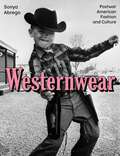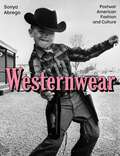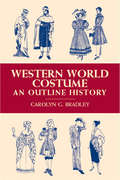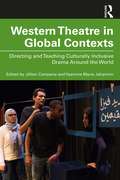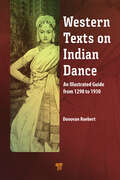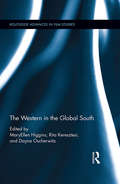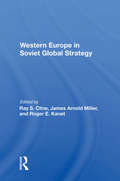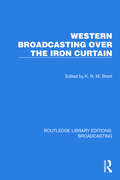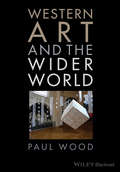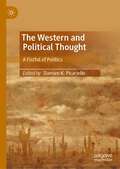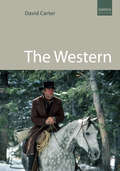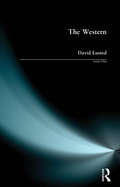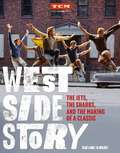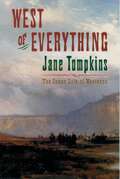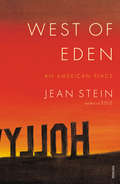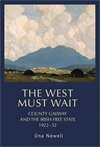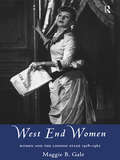- Table View
- List View
Westernwear: Postwar American Fashion and Culture
by Sonya AbregoDuring the prosperous, forward-thinking era after the Second World War, a growing number of men, women, and children across the United States were wearing fashions that evoked the Old West. Westernwear: Postwar American Fashion and Culture examines why a sartorial style with origins in 19th-century agrarian traditions continued to be worn at a time when American culture sought balance between technocratic confidence in science and technology on one side, and fear and anxiety over global annihilation on the other. By analysing well-known and rarely considered western manufacturers, Westernwear revises the common perception that fashionable innovation came from the East coast and places western youth cultures squarely back in the picture. The book connects the history of American working class dress with broader fashionable trends and discusses how and why Native American designs and representations of Native American people were incorporated broadly and inconsistently into the western visual vocabulary. Setting westernwear firmly in context, Sonya Abrego addresses the incorporation of this iconic style into postwar wardrobes and popular culture, and charts the evolution of westernwear into a modern fashion phenomenon.
Westernwear: Postwar American Fashion and Culture
by Sonya AbregoDuring the prosperous, forward-thinking era after the Second World War, a growing number of men, women, and children across the United States were wearing fashions that evoked the Old West. Westernwear: Postwar American Fashion and Culture examines why a sartorial style with origins in 19th-century agrarian traditions continued to be worn at a time when American culture sought balance between technocratic confidence in science and technology on one side, and fear and anxiety over global annihilation on the other. By analysing well-known and rarely considered western manufacturers, Westernwear revises the common perception that fashionable innovation came from the East coast and places western youth cultures squarely back in the picture. The book connects the history of American working class dress with broader fashionable trends and discusses how and why Native American designs and representations of Native American people were incorporated broadly and inconsistently into the western visual vocabulary. Setting westernwear firmly in context, Sonya Abrego addresses the incorporation of this iconic style into postwar wardrobes and popular culture, and charts the evolution of westernwear into a modern fashion phenomenon.
Western World Costume: An Outline History (Dover Pictorial Archive Ser.)
by Carolyn G. BradleyFrom prehistory to the mid-20th century, this informative book describes and illustrates the development of Western dress. The text — enhanced by nearly 500 illustrations — appears in outline form, permitting easy cross-referencing of material. Details of distinctive features for each era include footwear, headgear, accessories, and typical colors and materials. 491 black-and-white illustrations.
Western Theatre in Global Contexts: Directing and Teaching Culturally Inclusive Drama Around the World
by Yasmine Jahanmir Jillian CampanaWestern Theatre in Global Contexts explores the junctures, tensions, and discoveries that occur when teaching Western theatrical practices or directing English-language plays in countries that do not share Western theatre histories or in which English is the non-dominant language. This edited volume examines pedagogical discoveries and teaching methods, how to produce specific plays and musicals, and how students who explore Western practices in non-Western places contribute to the art form. Offering on-the-ground perspectives of teaching and working outside of North American and Europe, the book analyzes the importance of paying attention to the local context when developing theatrical practice and education. It also explores how educators and artists who make deep connections in the local culture can facilitate ethical accessibility to Western models of performance for students, practitioners and audiences. Western Theatre in Global Contexts is an excellent resource for scholars, artists, and teachers that are working abroad or on intercultural projects in theatre, education and the arts.
Western Theatre in Global Contexts: Directing and Teaching Culturally Inclusive Drama Around the World
by Yasmine Jahanmir Jillian CampanaWestern Theatre in Global Contexts explores the junctures, tensions, and discoveries that occur when teaching Western theatrical practices or directing English-language plays in countries that do not share Western theatre histories or in which English is the non-dominant language. This edited volume examines pedagogical discoveries and teaching methods, how to produce specific plays and musicals, and how students who explore Western practices in non-Western places contribute to the art form. Offering on-the-ground perspectives of teaching and working outside of North American and Europe, the book analyzes the importance of paying attention to the local context when developing theatrical practice and education. It also explores how educators and artists who make deep connections in the local culture can facilitate ethical accessibility to Western models of performance for students, practitioners and audiences. Western Theatre in Global Contexts is an excellent resource for scholars, artists, and teachers that are working abroad or on intercultural projects in theatre, education and the arts.
Western Texts on Indian Dance: An Illustrated Guide from 1298 to 1930
by Donovan RoebertThis unique work is an annotated collection and collation of Western writing on Indian dance from the period of Marco Polo’s travels to India to the formulation of the anti-devadasi bill in 1930, and a little beyond. The book reproduces more than 250 extracts from important texts, which provide examples of how dance in India was perceived as an art, as well its position in the broader cultural, religious, social, and ethical environment. Though some excerpts from these texts are cited in other writings on Indian dance history, there is no other available work that reproduces such a large number of historical writings on Indian dance and places them in a fluid historical context.
Western Texts on Indian Dance: An Illustrated Guide from 1298 to 1930
by Donovan RoebertThis unique work is an annotated collection and collation of Western writing on Indian dance from the period of Marco Polo’s travels to India to the formulation of the anti-devadasi bill in 1930, and a little beyond. The book reproduces more than 250 extracts from important texts, which provide examples of how dance in India was perceived as an art, as well its position in the broader cultural, religious, social, and ethical environment. Though some excerpts from these texts are cited in other writings on Indian dance history, there is no other available work that reproduces such a large number of historical writings on Indian dance and places them in a fluid historical context.
The Western in the Global South (Routledge Advances in Film Studies)
by MaryEllen Higgins Rita Keresztesi Dayna OscherwitzThe Western in the Global South investigates the Western film genre's impact, migrations, and reconfigurations in the Global South. Contributors explore how cosmopolitan directors have engaged with, appropriated, and subverted the tropes and conventions of Hollywood and Italian Westerns, and how Global South Westerns and Post-Westerns in particular address the inequities brought about by postcolonial patriarchy, globalization and neoliberalism. The book offers a wide range of historical engagements with the genre, from African, Caribbean, South and Southeast Asian, Central and South American, and transnational directors. The contributors employ interdisciplinary cultural studies approaches to cinema, integrating aesthetic considerations with historical, political, and gender studies readings of the international appropriations and U.S. re-appropriations of the Western genre.
The Western in the Global South (Routledge Advances in Film Studies)
by MaryEllen Higgins Rita Keresztesi Dayna OscherwitzThe Western in the Global South investigates the Western film genre's impact, migrations, and reconfigurations in the Global South. Contributors explore how cosmopolitan directors have engaged with, appropriated, and subverted the tropes and conventions of Hollywood and Italian Westerns, and how Global South Westerns and Post-Westerns in particular address the inequities brought about by postcolonial patriarchy, globalization and neoliberalism. The book offers a wide range of historical engagements with the genre, from African, Caribbean, South and Southeast Asian, Central and South American, and transnational directors. The contributors employ interdisciplinary cultural studies approaches to cinema, integrating aesthetic considerations with historical, political, and gender studies readings of the international appropriations and U.S. re-appropriations of the Western genre.
Western Europe In Soviet Global Strategy
by Ray S. ClineSoviet global strategy, long established and well understood by the Kremlin leaders, is to intimidate weak and fearful governments, exploit indigenous difficulties, disrupt social order, and promote communist revolutions. In this volume, European and American scholars describe the USSR's land and sea targets on and surrounding West Europe, where t
Western Europe In Soviet Global Strategy
by Ray S. ClineSoviet global strategy, long established and well understood by the Kremlin leaders, is to intimidate weak and fearful governments, exploit indigenous difficulties, disrupt social order, and promote communist revolutions. In this volume, European and American scholars describe the USSR's land and sea targets on and surrounding West Europe, where t
Western Broadcasting over the Iron Curtain (Routledge Library Editions: Broadcasting #38)
by K.R.M. ShortWestern Broadcasting Over the Iron Curtain (1986) examines the development of broadcasting policy by Western democracies, levels of government control of policy, efforts by communist regimes to minimize the effects of western broadcasting, and Soviet and Eastern European audience opinions on such diverse subjects as the success or failure of socialism and the Korean airline disaster.
Western Broadcasting over the Iron Curtain (Routledge Library Editions: Broadcasting #38)
Western Broadcasting Over the Iron Curtain (1986) examines the development of broadcasting policy by Western democracies, levels of government control of policy, efforts by communist regimes to minimize the effects of western broadcasting, and Soviet and Eastern European audience opinions on such diverse subjects as the success or failure of socialism and the Korean airline disaster.
Western Art and the Wider World
by Paul WoodWestern Art and the Wider World explores the evolving relationship between the Western canon of art, as it has developed since the Renaissance, and the art and culture of the Islamic world, the Far East, Australasia, Africa and the Americas. Explores the origins, influences, and evolving relationship between the Western canon of art as it has developed since the Renaissance and the art and culture of the Islamic world, the Far East, Australasia, Africa and the Americas Makes the case for ‘world art’ long before the fashion of globalization Charts connections between areas of study in art that long were considered in isolation, such as the Renaissance encounter with the Ottoman Empire, the influence of Japanese art on the 19th-century French avant-garde and of African art on early modernism, as well as debates about the relation of ‘contemporary art’ to the past. Written by a well-known art historian and co-editor of the landmark Art in Theory volumes
Western Art and the Wider World
by Paul WoodWestern Art and the Wider World explores the evolving relationship between the Western canon of art, as it has developed since the Renaissance, and the art and culture of the Islamic world, the Far East, Australasia, Africa and the Americas. Explores the origins, influences, and evolving relationship between the Western canon of art as it has developed since the Renaissance and the art and culture of the Islamic world, the Far East, Australasia, Africa and the Americas Makes the case for ‘world art’ long before the fashion of globalization Charts connections between areas of study in art that long were considered in isolation, such as the Renaissance encounter with the Ottoman Empire, the influence of Japanese art on the 19th-century French avant-garde and of African art on early modernism, as well as debates about the relation of ‘contemporary art’ to the past. Written by a well-known art historian and co-editor of the landmark Art in Theory volumes
The Western and Political Thought: A Fistful of Politics
by Damien K. PicarielloThe Western and Political Thought: A Fistful of Politics offers a variety of engaging and entertaining answers to the question: What do Westerns have to do with politics? This collection features contributions from scholars in a variety of fields—political science, English, communication studies, and others—that explore the connections between Westerns (prose fiction, films, television series, and more) and politics.
The Western
by David CarterFrom the very beginnings of cinema in America the Western has been a central genre. The hazardous lives of the settlers, their conflict with Native Americans (the Indians), the lawless frontier towns, outlaws and cattle rustlers, all found their way into the new medium of film. Folk heroes and heroines, such as Jesse and Frank James, Wild Bill Hickok, Wyatt Earp, Calamity Jane and Annie Oakley, were all eagerly seized on by filmmakers. From the popular to the more literary, writers such as Zane Grey, Owen Wister and James Fennimore Cooper were plundered for storylines. The Western became popular worldwide because it offered escape, adventure, stunning landscapes and romance; also themes that resonated such as survival, law and order, defence of family, and dreams of a new and better world. David Carter's book starts with an introduction to the real American West and its famous historical figures, and traces the development of the genre from popular literature, through the early silent films, the sound era, the Golden Age of classic Westerns, TV and 'spaghetti westerns', to the self-reflexive and revisionist Westerns of recent decades. It provides a basic work of reference for all the major directors and noteworthy films of the genre. The great Hollywood directors are all here, such as John Ford, Howard Hawks, Raoul Walsh, Michael Curtiz, Sam Peckinpah and Henry Hathaway, and great stars including John Wayne, James Stewart, Gary Cooper, Barbara Stanwyck, Jane Russell and Clint Eastwood.
The Western (Inside Film)
by David LustedThe Western introduces the novice to the pleasures and the meanings of the Western film, shares the excitement of the genre with the fan, addresses the suspicions of the cynic and develops the knowledge of the student. The Western is about the changing times of the Western, and about how it has been understood in film criticism. Until the 1980s, more Westerns were made than any other type of film. For fifty of those years, the genre was central to Hollywood's popularity and profitability. The Western explores the reasons for its success and its latter-day decline among film-makers and audiences alike. Part I charts the history of the Western film and its role in film studies. Part II traces the origins of the Western in nineteenth-century America, and in its literary, theatrical and visual imagining. This sets the scene to explore the many evolving forms in successive chapters on early silent Westerns, the series Western, the epic, the romance, the dystopian, the elegiac and, finally, the revisionist Western. The Western concludes with an extensive bibliography, filmography and select further reading. Over 200 Westerns are discussed, among them close accounts of classics such as Duel in the Sun, The Wild Bunch and Unforgiven, formative titles like John Ford's epic The Iron Horse, and early cowboy star William S. Hart's The Silent One together with less familiar titles that deserve wider recognition, including Comanche Station, Pursued and Ulzana's Raid.
The Western (Inside Film)
by David LustedThe Western introduces the novice to the pleasures and the meanings of the Western film, shares the excitement of the genre with the fan, addresses the suspicions of the cynic and develops the knowledge of the student. The Western is about the changing times of the Western, and about how it has been understood in film criticism. Until the 1980s, more Westerns were made than any other type of film. For fifty of those years, the genre was central to Hollywood's popularity and profitability. The Western explores the reasons for its success and its latter-day decline among film-makers and audiences alike. Part I charts the history of the Western film and its role in film studies. Part II traces the origins of the Western in nineteenth-century America, and in its literary, theatrical and visual imagining. This sets the scene to explore the many evolving forms in successive chapters on early silent Westerns, the series Western, the epic, the romance, the dystopian, the elegiac and, finally, the revisionist Western. The Western concludes with an extensive bibliography, filmography and select further reading. Over 200 Westerns are discussed, among them close accounts of classics such as Duel in the Sun, The Wild Bunch and Unforgiven, formative titles like John Ford's epic The Iron Horse, and early cowboy star William S. Hart's The Silent One together with less familiar titles that deserve wider recognition, including Comanche Station, Pursued and Ulzana's Raid.
West Side Story: The Jets, the Sharks, and the Making of a Classic (Turner Classic Movies)
by Richard BarriosA captivating, richly illustrated full account of the making of the ground-breaking movie classic West Side Story (1961).A major hit on Broadway, on film West Side Story became immortal-a movie different from anything that had come before, but this cinematic victory came at a price. In this engrossing volume, film historian Richard Barrios recounts how the drama and rivalries seen onscreen played out to equal intensity behind-the-scenes, while still achieving extraordinary artistic feats.The making and impact of West Side Story has so far been recounted only in vestiges. In the pages of this book, the backstage tale comes to life along with insight on what has made the film a favorite across six decades: its brilliant use of dance as staged by erstwhile co-director Jerome Robbins; a meaningful story, as set to Leonard Bernstein and Stephen Sondheim's soundtrack; the performances of a youthful ensemble cast featuring Natalie Wood, Rita Moreno, George Chakiris, and more; a film with Shakespearean roots (Romeo and Juliet) that is simultaneously timeless and current. West Side Story was a triumph that appeared to be very much of its time; over the years it has shown itself to be eternal.
West of Everything: The Inner Life of Westerns
by Jane TompkinsA leading figure in the debate over the literary canon, Jane Tompkins was one of the first to point to the ongoing relevance of popular women's fiction in the 19th century, long overlooked or scorned by literary critics. Now, in West of Everything, Tompkins shows how popular novels and films of the American west have shaped the emotional lives of people in our time. Into this world full of violence and manly courage, the world of John Wayne and Louis L'Amour, Tompkins takes her readers, letting them feel what the hero feels, endure what he endures. Writing with sympathy, insight, and respect, she probes the main elements of the Western--its preoccupation with death, its barren landscapes, galloping horses, hard-bitten men and marginalized women--revealing the view of reality and code of behavior these features contain. She considers the Western hero's attraction to pain, his fear of women and language, his desire to dominate the environment--and to merge with it. In fact, Tompkins argues, for better or worse Westerns have taught us all--men especially--how to behave. It was as a reaction against popular women's novels and women's invasion of the public sphere that Westerns originated, Tompkins maintains. With Westerns, men were reclaiming cultural territory, countering the inwardness, spirituality, and domesticity of the sentimental writers, with a rough and tumble, secular, man-centered world. Tompkins brings these insights to bear in considering film classics such as Red River and Lonely Are the Brave, and novels such as Louis L'Amour's Last of the Breed and Owen Wister's The Virginian. In one of the most moving chapters (chosen for Best American Essays of 1991), Ttompkins shows how the life of Buffalo Bill Cody, killer of Native Americans and charismatic star of the Wild West show, evokes the contradictory feelings which the Western typically elicits--horror and fascination with violence, but also love and respect for the romantic ideal of the cowboy. Whether interpreting a photograph of John Wayne of meditating on the slaughter of cattle, Jane Tompkins writes with humor, compassion, and a provocative intellect. Her book will appeak to many Americans who read or watch Westerns, and to all those interested in a serious approach to popular culture.
West of Everything: The Inner Life of Westerns
by Jane TompkinsA leading figure in the debate over the literary canon, Jane Tompkins was one of the first to point to the ongoing relevance of popular women's fiction in the 19th century, long overlooked or scorned by literary critics. Now, in West of Everything, Tompkins shows how popular novels and films of the American west have shaped the emotional lives of people in our time. Into this world full of violence and manly courage, the world of John Wayne and Louis L'Amour, Tompkins takes her readers, letting them feel what the hero feels, endure what he endures. Writing with sympathy, insight, and respect, she probes the main elements of the Western--its preoccupation with death, its barren landscapes, galloping horses, hard-bitten men and marginalized women--revealing the view of reality and code of behavior these features contain. She considers the Western hero's attraction to pain, his fear of women and language, his desire to dominate the environment--and to merge with it. In fact, Tompkins argues, for better or worse Westerns have taught us all--men especially--how to behave. It was as a reaction against popular women's novels and women's invasion of the public sphere that Westerns originated, Tompkins maintains. With Westerns, men were reclaiming cultural territory, countering the inwardness, spirituality, and domesticity of the sentimental writers, with a rough and tumble, secular, man-centered world. Tompkins brings these insights to bear in considering film classics such as Red River and Lonely Are the Brave, and novels such as Louis L'Amour's Last of the Breed and Owen Wister's The Virginian. In one of the most moving chapters (chosen for Best American Essays of 1991), Ttompkins shows how the life of Buffalo Bill Cody, killer of Native Americans and charismatic star of the Wild West show, evokes the contradictory feelings which the Western typically elicits--horror and fascination with violence, but also love and respect for the romantic ideal of the cowboy. Whether interpreting a photograph of John Wayne of meditating on the slaughter of cattle, Jane Tompkins writes with humor, compassion, and a provocative intellect. Her book will appeak to many Americans who read or watch Westerns, and to all those interested in a serious approach to popular culture.
West of Eden: An American Place
by Jean SteinWest of Eden is the definitive story of Hollywood, told, in their own words, by the people on the inside: Lauren Bacall, Arthur Miller, Dennis Hopper, Frank Gehry, Ring Lardner, Joan Didion, Stephen Sondheim – all interviewed by Jean Stein, who grew up in the Forties in a fairytale mansion in the Hollywood Hills.The book takes us from the discovery of oil in the Twenties with the story of the tycoon Edward Doheny (There Will Be Blood) and traces the growth of corruption through the syndicates, the mob, and the movie studios – from the beginnings of the film industry to the end, with News Corp. and Rupert Murdoch (who bought the Stein mansion in 1985).West of Eden is about money, power, fame and terrible secrets: the doomed Hollywood of the late Fifties, early Sixties – ‘the rotten heart of paradise’. Like her last book, the best-selling Edie, this is an oral history told through brilliantly edited interviews. As this is Hollywood, it’s a book full of sex, drugs and celebrity glamour; but because it’s built from the firsthand accounts of people who were actually there, many of them writers, actors and artists, it’s also strangely claustrophobic, seductive, and completely compelling.
The West must wait: County Galway and the Irish Free State, 1922–32 (PDF)
by Úna NewelThe West must wait presents a new perspective on the development of the Irish Free State. It extends the regional historical debate beyond the Irish revolution and raises a series of challenging questions about post-civil war society in Ireland. Through a detailed examination of key local themes – land, poverty, politics, emigration, the status of the Irish language, the influence of radical republicans and the authority of the Catholic Church – it offers a probing analysis of the socio-political realities of life in the new state. This book opens up a new dimension by providing a rural contrast to the Dublin-centred views of Irish politics. Significantly, it reveals the level of deprivation in local Free State society with which the government had to confront in the west. Rigorously researched, it explores the disconnect between the perceptions of what independence would deliver and what was achieved by the incumbent Cumann na nGaedheal administration.
West End Women: Women and the London Stage 1918 - 1962 (Gender in Performance)
by Maggie GaleMaggie Gale's West End Women uncovers groundbreaking material about women playwrights and the staging of their performances between the years 1918 and 1962. It documents a dynamic era of social and theatrical history, analysing the transformations that occurred in the theatre and the lives of British women in relation to specific plays of the period. Focusing on the work of playwrights such as Dodie Smith, Clemence Dane, Gordon Daviot and Bridget Boland, Maggie Gale examines the cultural and political context within which they enjoyed commercial success and great notoriety.
